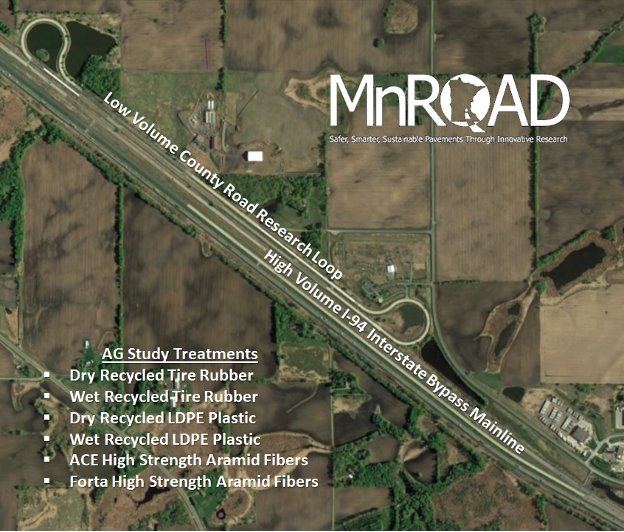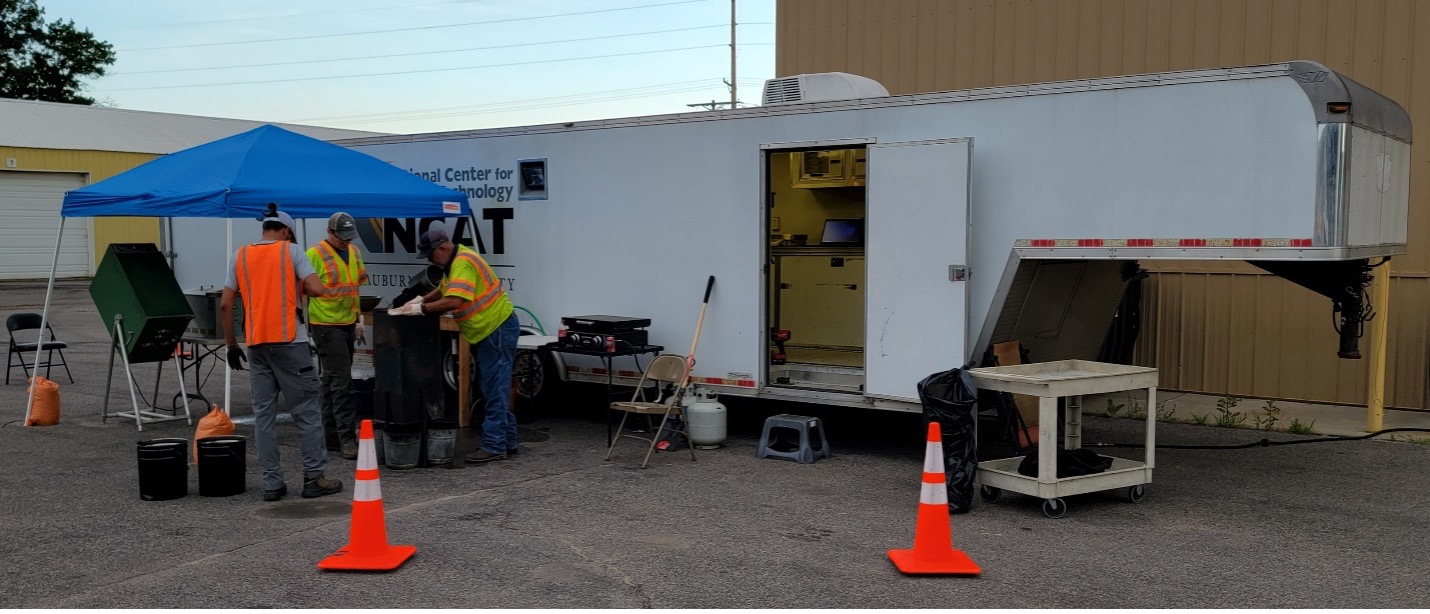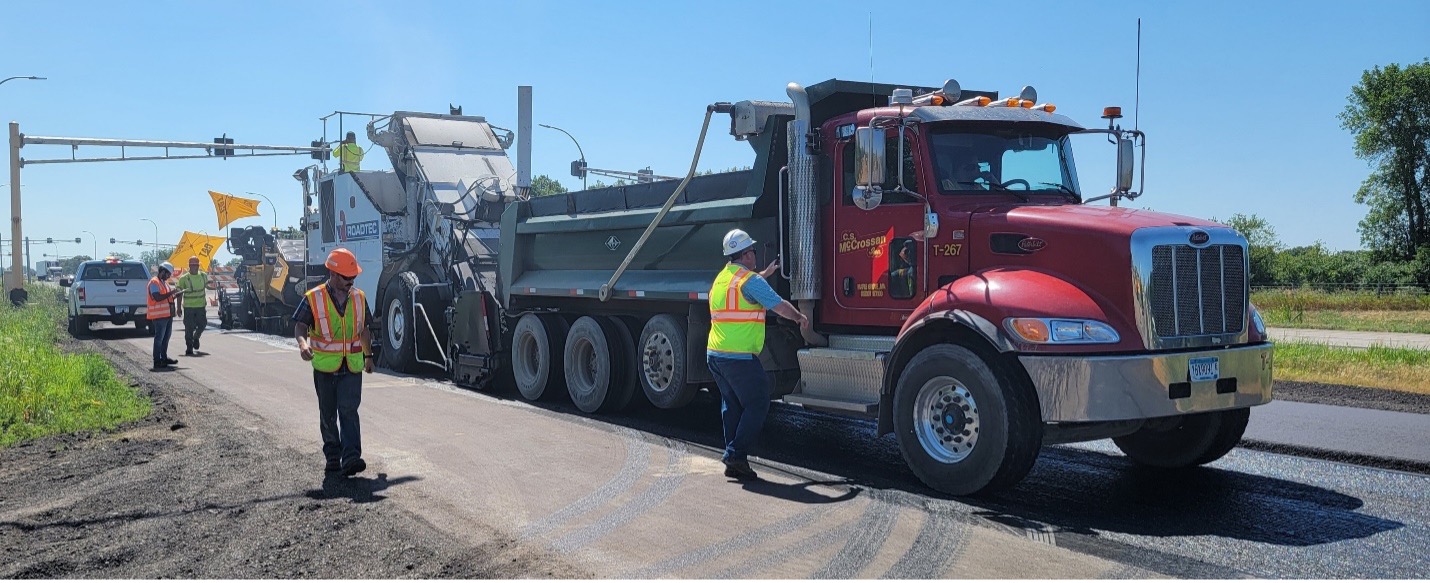- Fall 2022
MnROAD Additive Group Test Section Construction
Full-scale accelerated pavement testing has been conducted at the Minnesota DOT Road Research Facility (MnROAD) and the NCAT Test Track for more than two decades. These proven and practical research facilities formed a partnership in 2015 that is cooperatively funded by state DOTs from all over the country to execute flexible pavement studies targeting national research priorities.
The objective of the additive group (AG) experiment, sponsored by seven state DOTs and FHWA, is to measure the impact of recycled and premium mix additives on pavement life in both southern and northern US climates. Southern sections were built on the NCAT Test Track in the summer of 2021 to quantify the impact of the mix additives on fatigue cracking. Northern sections were built on the MnROAD high-volume I-94 interstate mainline bypass in the summer of 2022 to quantify the impact of the mix additives on thermal and reflective cracking.

High volume I-94 Interstate bypass mainline test sections at MnROAD.
For the MnROAD test sections, mix designs with the additives were developed using a balanced mix design (BMD) approach at NCAT in the spring of 2021. Aggregates and binder grades appropriate for southcentral Minnesota were utilized. Five inches of a control mix was placed in two 2.5-inch lifts on carefully prepared base, subbase, and subgrade materials common for Minnesota in each of the 450-foot AG test sections. Full depth (24-inch) transverse saw cuts were made at 25- and 50-foot spacings to simulate existing thermal cracks. The top inch was milled off, CSS-1H tack was applied at a bar rate of 0.07 gallons per square yard, and all research mixes were placed in a 2-inch lift on the surface. Milling was completed by Caterpillar, the mix was produced by Martin Marietta at their Elk River, MN plant, and the mix was placed by C.S. McCrossan from Maple Grove, MN. All mix was produced and placed the week of July 18, 2022. NCAT was responsible for plant settings and mix quality testing at the Elk River asphalt plant. The NCAT portable laboratory was set up at MnDOT’s Elk River truck yard just a few miles down the road from the asphalt plant.

NCAT’s portable laboratory at the MnDOT Elk River truck yard.
Dry recycled tire rubber and recycled plastic additives were introduced into the Dillman counterflow drum plant with a Hi-Tech Asphalt Solutions feed system. Both brands of high strength aramid fibers were introduced into the plant using portable systems provided by the manufacturers. Rates were independently verified and documented by NCAT personnel. Wet additives were pumped directly from preblended tanker trailers that were temporarily plumbed to the plant. Practice mix (typically 100 tons) was sampled at the plant, transported to the truck yard, and tested in the NCAT portable lab. Asphalt content, washed gradation, and volumetric properties were measured to make sure the produced mix was proportioned in accordance with the mix design. Additionally, both IDEAL-CT and Hot-IDT samples were prepared. Plant settings were adjusted as necessary by NCAT personnel, and mix was produced (typically 200 tons for each section) and hauled to the jobsite for placement.
NCAT staff also collected data at the plant and construction site to support the life cycle assessment (LCA) of the additive. Particulate matter sensors provided by Applied Particle Technology, Inc. were installed at the top of the mix storage silo on each side of the batcher. Sensor data was transmitted via wireless connection to cloud storage for further analysis. Feedstock material quantities, burner fuel consumption, and electricity measurements required for cradle-to-gate LCA stage were documented for each mix. Operational and idling times of construction equipment (material transfer vehicle, paver, and compactors) were documented to quantify each test section's construction phase emissions. The performance data collection required for quantifying use stage LCA will continue when the mainline is open to traffic.
MnROAD personnel were responsible for monitoring paving operations and collecting mat quality data such as density and smoothness. Intelligent construction technologies were utilized extensively in this effort. A paver mounted thermal imaging system documented thermal uniformity, and ground penetration radar (GPR) was used to verify thickness consistency. Intelligent compaction was used to document the compaction process, nuclear gauges corrected to cores were used to establish rolling patterns and measure spot densities, and a density profile system measured density over the entire section. Construction quality was very good with preliminary densities for all the additive test sections ranging from a low of 94.5% to a high of 95.9% with an overall average of 95%.

Truck lane paving at the southeast end of MnROAD’s I-94 Interstate bypass mainline.
The northern AG sections are opening to traffic in fall 2022 after all construction activities and baseline data collection have been completed. The observed performance of each section will be compared to a conventional control section with a focus on thermal and reflective cracking. Any additive section that statistically outlasts the control section will be a demonstration of improved performance.
A similar process is underway at the NCAT Test Track with a focus on fatigue cracking. The two products of the research will be the quantified impact of each additive on mix performance and a validated framework for testing and modeling of pavements that won’t require the construction of test sections. Agencies will then be equipped to make life cycle investment decisions for additives included in the study as well as build a qualified products list for additives that weren’t included in the Additive Group experiment.



For more information on this article, please contact Buzz Powell (left), Nathan Moore (center), or Suri Gatiganti (right).